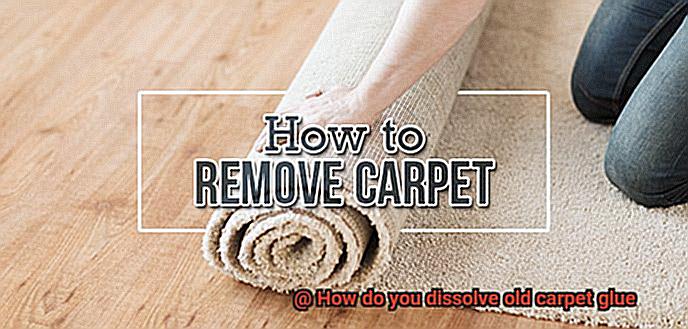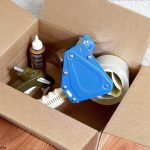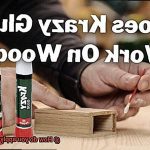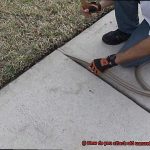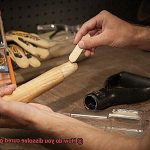Hey there, DIY enthusiasts and home renovation junkies. Sick of staring at that tired, old carpet glue clinging stubbornly to your hardwood floors? Ready to give your space a fresh new look? Well, you’ve hit the jackpot.
In today’s blog post, we’re diving deep into the captivating world of carpet glue dissolution. We’ll explore all the methods and products that can help you conquer this seemingly daunting task. Whether you’re dealing with a small patch or an entire room covered in sticky residue, we’ve got your back.
But before we get into the nitty-gritty, let’s talk about why removing old carpet glue is so crucial. Not only does it ruin the beauty of your floors, but it can also throw a wrench in the works when installing new flooring. That’s where the magic of dissolving old carpet glue comes in.
So grab a cup of coffee, throw on those safety goggles, and get ready to learn everything you need to know to bid farewell to that pesky carpet glue. Let’s embark on this transformative journey together.
Using solvent or adhesive remover
Contents
- 1 Using solvent or adhesive remover
- 2 Applying heat to soften the glue
- 3 Vinegar as a natural solution
- 4 Citrus-based solvents
- 5 Mechanical methods for removing old carpet glue
- 6 Testing a small area before full application
- 7 Cleaning the surface after removing the glue
- 8 Challenges and considerations in removing old carpet glue
- 9 Conclusion
Bid farewell to the stubborn old carpet glue that has been haunting your floors. With the right tools and techniques, you can conquer this challenging task. Solvents and adhesive removers are your secret weapons in dissolving that adhesive nightmare. In this comprehensive guide, we will take you through each step of the process, while also emphasizing important precautions to ensure your safety.
Step 1: Prepare the battlefield
Before diving into battle, create a well-ventilated work area. Open windows and set up fans to improve air circulation. This will shield you from inhaling any strong fumes that may be emitted by the solvents or adhesive removers.
Step 2: Choose your mighty weapon
Arm yourself with the right product for the job. Explore the wide range of solvents and adhesive removers available on the market. Study their labels meticulously and select a product specifically designed for removing carpet glue. Acetone and mineral spirits are popular choices, but remember to consider the type of surface and carpet fibers before making your final selection.
Step 3: Test the waters
To avoid unleashing unintended damage, test your chosen product on a small, inconspicuous area of the surface. Apply a small amount of solvent or adhesive remover and patiently wait for a few minutes. If no adverse reaction occurs, you can proceed confidently.
Step 4: Unleash the power
Equip yourself with a clean cloth or sponge, and generously apply your chosen solvent or adhesive remover to the carpet glue. Allow it to marinate for several minutes, giving the product ample time to penetrate and break down those stubborn adhesive bonds.
Step 5: Defeat the enemy
Once you’ve softened the glue, summon your trusty scraper or putty knife. With precision and care, gently scrape away the softened glue from the surface. Be mindful of the underlying material, ensuring it remains unscathed. If necessary, apply more solvent or adhesive remover and repeat the process until victory is achieved, and all traces of glue are vanquished.
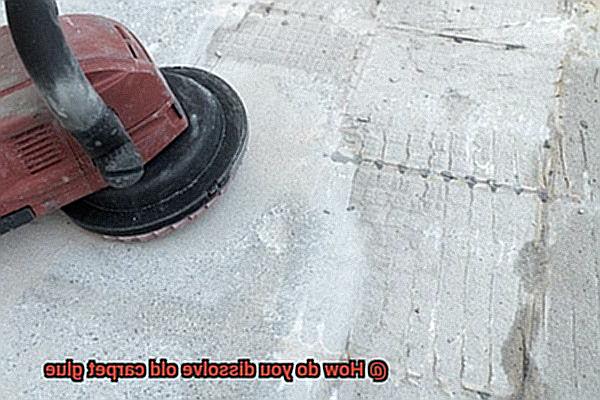
Step 6: Cleanse and restore
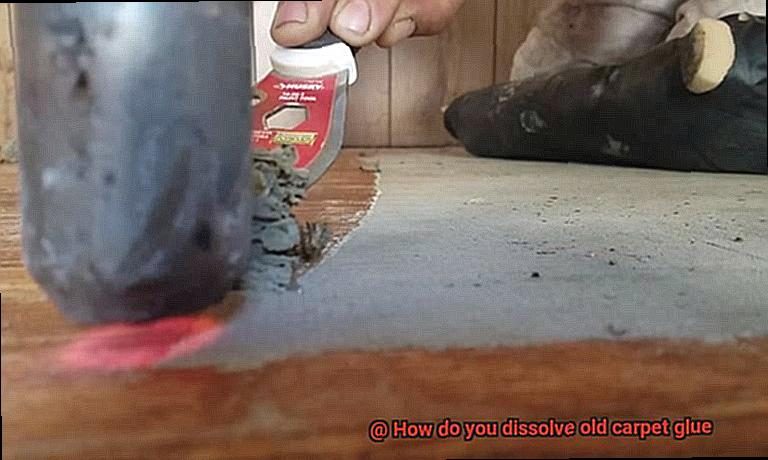
After the battle is won, cleanse the battlefield with warm water and a mild detergent. Thoroughly remove any residue or leftover solvent. Rinse the area with clean water and ensure it is completely dry before proceeding with any further treatments or installations.
Precautions:
- Don your armor of gloves and safety goggles to protect your skin and eyes from the potent solvents and adhesive removers.
- Banish all flames from the vicinity, for some solvents are highly flammable.
- Dispose of used solvents or adhesive removers in accordance with local regulations.
- Seek guidance and assistance from a professional if you’re uncertain about using solvents or adhesive removers.
Applying heat to soften the glue
Prepare yourself for an epic showdown against old carpet glue, a formidable opponent that refuses to let go. Fear not, for there is a mighty force in your arsenal that will turn the tide in your favor – heat.
By harnessing the power of heat to soften the glue, you can conquer the removal process with ease. In this enlightening article, we will explore various methods of applying heat to defeat stubborn adhesive, including wielding a heat gun or hairdryer, unleashing the steamy wrath of a steam cleaner or steam iron, and even summoning the boiling waters.
Method 1: Heat Gun or Hairdryer
- Set your heat gun or hairdryer to high and prepare for battle.
- Channel the scorching airflow onto the glue, moving it continuously like a skilled warrior.
- As the heat infiltrates the adhesive, it becomes pliable and vulnerable.
- Wield a heat-resistant scraper or putty knife to vanquish the softened glue from its stronghold.
Method 2: Steam Cleaner or Steam Iron
- Summon the forces of steam by employing a steam cleaner’s nozzle.
- Alternatively, take up arms with a damp towel and unleash the steam iron upon it.
- The steam’s relentless assault softens the adhesive, leaving it defenseless against your scraping prowess.
- This method is particularly effective when facing larger areas or stubborn residue that refuses to yield.
Method 3: Boiling Water
- With utmost caution, pour boiling water onto the battleground.
- Allow it to permeate the area for a few minutes, letting its scorching heat penetrate the adhesive’s resolve.
- The boiling water weakens the grip of the glue, making it more manageable and susceptible to defeat.
- Remember to handle boiling water with care to avoid burns or collateral damage.
Important Considerations:
- Breathe easy by ensuring proper ventilation during the heat application, preventing any harmful fumes from clouding your path to victory.
- Test your chosen method on a small, inconspicuous area first to ensure it won’t mar the carpet or surface.
- Arm yourself with heat-resistant scrapers or putty knives to avoid accidents and injury.
- Safeguard surrounding materials during the battle by taking necessary precautions.
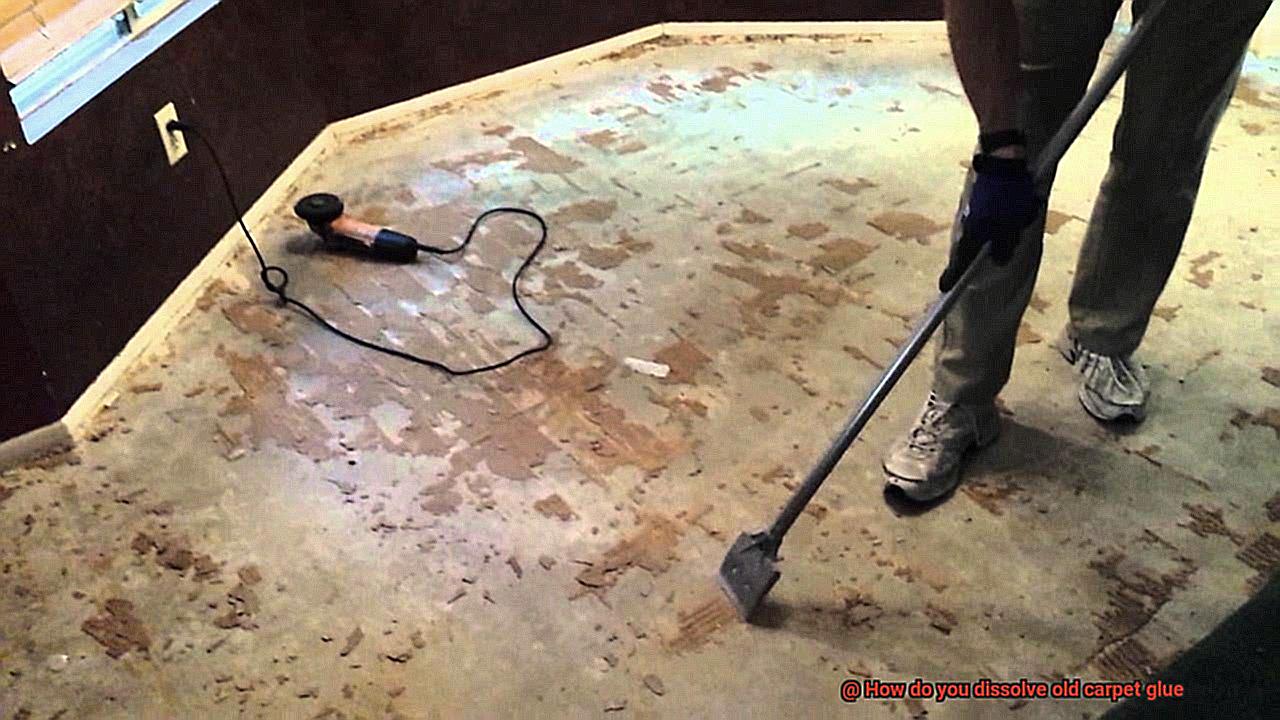
Vinegar as a natural solution
Don’t let the battle against old carpet glue overwhelm you. Fear not, for vinegar is here to save the day. This versatile household product is not only safe and non-toxic, but it also possesses impressive adhesive-dissolving powers. In this article, we’ll explore how vinegar can effectively dissolve old carpet glue, providing you with the ultimate natural solution.
The Power of Vinegar:
Vinegar’s secret weapon lies in its acetic acid content. This incredible liquid packs a powerful punch when it comes to breaking down adhesives. By applying vinegar to old carpet glue, you weaken the bond between the adhesive and the surface, making it a breeze to remove.
Using Vinegar as a Natural Solution:
To unlock vinegar’s full potential, start by diluting it with water. A mixture of equal parts vinegar and water is recommended to prevent any potential damage or discoloration that pure vinegar might cause. Once your vinegar solution is mixed and ready, it’s time to put it to work.
- Application: Directly apply the vinegar solution to areas where the old carpet glue resides. Ensure even distribution using a spray bottle or sponge.
- Waiting Game: Allow the vinegar solution to work its magic for about 10-15 minutes. During this time, the acetic acid penetrates and breaks down the adhesive.
- Gentle Removal: After the waiting period, gently scrape away the dissolved glue with a putty knife or similar tool. Remember not to exert too much pressure, as this could damage the underlying surface. If necessary, repeat the process until all traces of old carpet glue are eliminated.
Advantages of Vinegar as a Natural Solution:
One of the greatest advantages of using vinegar is its safety and non-toxic nature. Unlike harsh chemical solvents, vinegar won’t release harmful fumes or pose health risks when used in a well-ventilated area. Moreover, vinegar is an affordable option that can be found in most households.
Conclusion:
Vinegar is a powerful natural solution for dissolving old carpet glue. Its acidic properties effectively weaken adhesives, making them a breeze to remove. However, keep in mind that success may vary depending on factors such as the type and age of the adhesive, as well as the condition of the carpet and underlying surface. If stubborn glue residues persist, additional methods or products may be necessary to ensure complete removal.
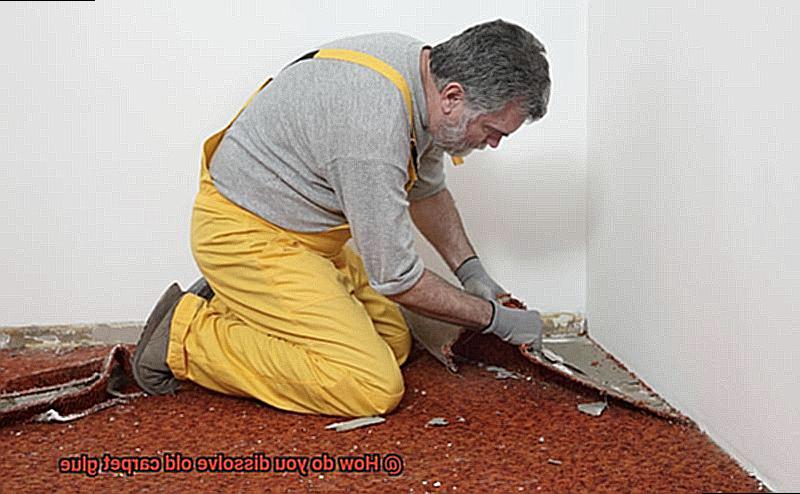
Citrus-based solvents
Say goodbye to the frustrating battle against stubborn old carpet glue and unleash the power of citrus-based solvents. These eco-friendly superheroes, derived from the zest of oranges and bursting with natural compounds, are here to revolutionize your adhesive adventures. Not only do they break down those pesky chemical bonds like a boss, but they do it without any harmful toxins or harsh chemicals. It’s like a breath of fresh air for your carpet.
So, let’s dive into the magical world of citrus-based solvents and discover how they work their wonders. Picture this: you’ve got an ancient carpet that has seen better days, and the glue holding it down is as tough as nails.
That’s where our citrus heroes swoop in to save the day.
When you apply a citrus-based solvent to the glue, its natural compounds get to work, dismantling those adhesive bonds with heroic precision. And guess what? These solvents are specifically designed to tackle water-based adhesives commonly used in carpet installations. It’s a match made in heaven.
But how do you wield the power of these citrus-based solvents to achieve maximum results? Well, my friend, let me enlighten you. First and foremost, always read and follow the manufacturer’s instructions carefully.
Safety first, after all. Don’t forget to gear up with protective gloves and goggles before embarking on your adhesive adventure. And here’s a pro-tip: test the solvent on a small inconspicuous area of the carpet first to ensure compatibility with your carpet fibers and colors.
Once you’re equipped and ready, it’s time to unleash the magic. Apply the citrus-based solvent generously to the glue and let it work its charm for a few minutes. Patience is key here, my friend. While you wait, observe in awe as the solvent effortlessly penetrates and dissolves that stubborn glue into submission. Once softened, grab your trusty putty knife or plastic scraper and gently scrape away the dissolved residue. Voila. Your carpet is on its way to newfound freedom.
Now, occasionally, a little residue may linger. But fear not. Just give it another dose of citrus-based solvent or a mild detergent solution, and that pesky glue will be nothing but a distant memory.
Mechanical methods for removing old carpet glue
Don’t let the daunting task of removing old carpet glue dampen your spirits. In this captivating article, we will delve into the enchanting world of mechanical methods that will help you bid farewell to that tenacious adhesive. Prepare to be amazed as we explore the transformative powers of scraping, heat application, sanding, floor buffering, and floor grinding.
Scraping:
Imagine wielding a sharp scraper or putty knife like a mighty warrior, fearlessly battling the remnants of old glue. With a delicate touch, scrape off the stubborn adhesive, revealing the pristine surface beneath. Just remember to exercise caution and finesse, ensuring that your victory over the glue doesn’t cause damage to the underlying floor.
Heat Application:
Harness the elemental power of heat to conquer the adhesive beast. Armed with a heat gun or hairdryer, unleash scorching temperatures that soften even the most formidable glue. As it surrenders to your radiant might, its grip weakens, making it a breeze to scrape away. But take heed. This method requires proper ventilation and careful handling to avoid burning yourself or your surroundings.
Sanding:
Smooth out imperfections while banishing old glue with the rhythmic dance of sanding. Equip yourself with a sander or sandpaper and embark on a journey of refinement. As you caress the surface, roughness dissipates like morning mist, leaving behind a polished masterpiece. This method not only eradicates the glue but also bestows upon you a flawless canvas.
Floor Buffering:
For grand endeavors and stubborn adversaries, call upon the mighty floor buffer. Clad in an abrasive pad, it becomes an unstoppable force against relentless glue. With each pass, it breaks down its resistance and liberates your floor from its clutches. But beware. The floor buffer is a formidable ally that requires skill and caution to prevent unintended harm to your floor.
Floor Grinding:
For those facing an army of thick layers of old carpet glue, the floor grinder is the ultimate weapon. Its rotating discs, adorned with abrasive stones, channel the power of a storm, grinding away the adhesive from concrete floors. But tread carefully, for this method demands expertise and is best entrusted to the hands of professionals.
Safety Precautions:
In this epic battle against old carpet glue, safety is your steadfast companion. Don your armor of gloves, goggles, and masks to protect yourself from the debris and dust that may rise in defiance. Proper ventilation becomes your lifeline when wielding the fiery forces of heat-based methods.
Testing a small area before full application
Testing a small area before full application is a sacred ritual for us, the brave warriors of the glue battlefield. Our mission: to defeat the beast known as old carpet glue. But before we charge into battle, let us delve into the importance of this essential step.
Why, you ask? Ah, my fellow glue enthusiasts, testing a small area is our shield against potential disaster. It allows us to assess the effectiveness of our chosen method without risking any damage to our precious carpets or underlying surfaces. Believe me when I say that chaos unleashed upon our floors is a sight we would all rather avoid.
First and foremost, let us talk about compatibility. Different types of carpet fibers and glues can have unique reactions to various solvents. By testing a small area, we can determine if our solution dances harmoniously with our specific carpet type. We wouldn’t want a patchy, discolored mess now, would we? No, my friends, we seek flawless victory.
Testing a small area also grants us insight into the effectiveness of our solution in dissolving the old carpet glue. As we apply the solution and witness the glue loosen its grip, we know that our chosen method is working its magic.
On the flip side, if there’s minimal or no effect on the glue, it might be time to rethink our approach or try a different solvent. Adaptation is key in this battle.
Some solutions require a little extra time to work their wonders on the stubborn adhesive. By testing a small area, we can gauge how long we should let the solution marinate before attempting to remove it. It’s all about finding that sweet spot of maximum effectiveness. Patience, my fellow warriors.
So, remember, my comrades in glue warfare: testing a small area before full application is not just an optional step – it is an absolute must. Take the time to assess compatibility, avoid potential damage, evaluate effectiveness, and determine the appropriate dwell time. This small effort can save you from costly mistakes and ensure victorious removal of that old carpet glue.
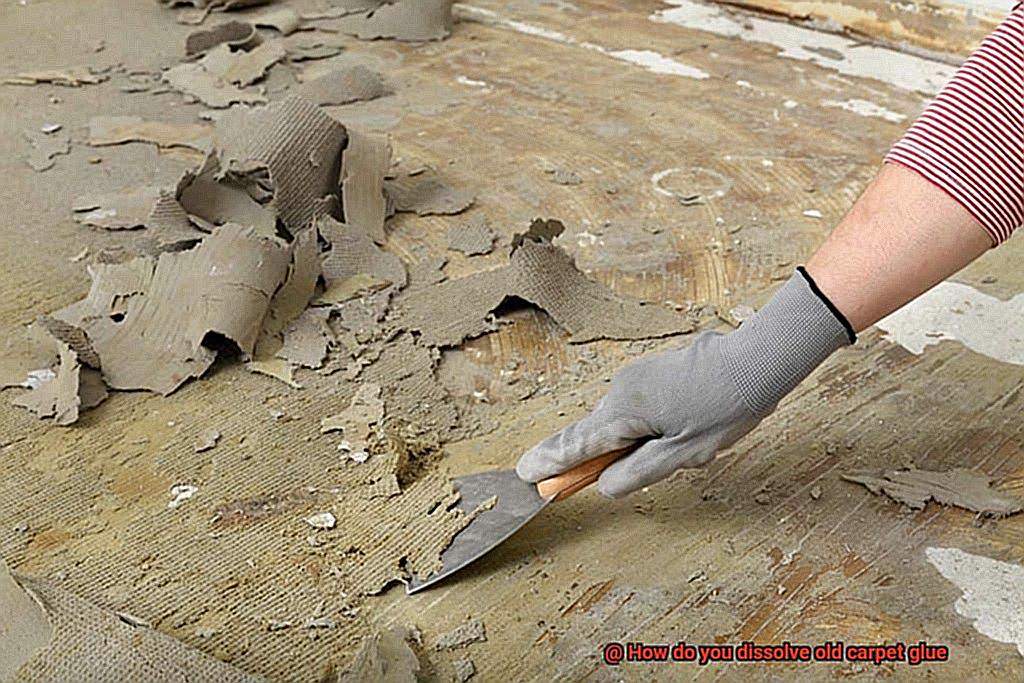
Cleaning the surface after removing the glue
Before you can truly declare victory, there is one final challenge to overcome: cleaning the surface and eradicating any lingering residue. Fear not, for I am here to guide you through this noble endeavor. Prepare yourself for a battle against stickiness armed with knowledge and effective cleaning solutions.
The Power of Soapy Solutions:
Prepare a bucket of warm water and add a few drops of mild dish soap or detergent. Thoroughly mix until a soapy solution forms. Equip yourself with a sponge or soft cloth, and dip it into the soapy water.
Gently scrub the surface where the glue once reigned supreme, paying extra attention to any visible residue. Rinse the sponge or cloth frequently in the soapy water to prevent reapplying any glue residue back onto the surface.
Harnessing the Mighty Vinegar:
Vinegar, the unsung hero of household cleaning, will be our ally in this battle. Combine equal parts white vinegar and warm water in a spray bottle. Spritz the solution onto the surface where the glue has been vanquished and allow it to sit for a few minutes, letting the vinegar work its magic.
Armed with a scrub brush or sponge, gently scrub the area in circular motions until all traces of residue are banished. Rinse with clean water and wipe dry with a cloth.
Unleashing the Acetone Avenger:
For those stubborn remnants that refuse to surrender, acetone is our secret weapon. Proceed with caution, as acetone can be harsh on certain surfaces, potentially causing damage or discoloration.
Test it on a small, inconspicuous area first for compatibility. Once deemed safe, apply a small amount of acetone onto a clean cloth or sponge and gently rub the residue until it starts to dissolve. Patience is key here; avoid excessive pressure to prevent surface damage. Wipe the area with a clean damp cloth to remove any remaining solvent, then rinse with water and dry thoroughly.
The Final Inspection:
After your valiant efforts, carefully inspect the surface for any remaining residue or stickiness. Should you spot any defiant glue, repeat the cleaning process using your chosen method until the surface is pristine. Once satisfied with the cleanliness, allow it to dry completely before proceeding with any further treatment or application.
Challenges and considerations in removing old carpet glue
The remnants of old carpet glue can be an unwelcome reminder of the past, clinging stubbornly to your floors. Whether you’re embarking on a home renovation or preparing for a fresh flooring installation, the task of removing this sticky residue can seem like an insurmountable challenge. Fear not, for in this article, we will delve into the challenges and considerations involved in conquering this sticky endeavor, equipping you with the knowledge needed to emerge victorious.
The Challenges:
Time and Effort:
Removing old carpet glue requires a patient and persistent approach. Brace yourself for a labor-intensive process that demands time and effort. Remember, just as Rome wasn’t built in a day, your glue removal project won’t be completed overnight.
Potential Damage to Floor Surfaces:
Carpet glue is engineered to firmly bond with the floor, making its elimination a daunting task that may result in scratches, residue, or marks. It is crucial to assess the condition of your underlying surface and prepare for potential repairs or refinishing.
Different Types of Glue:
Not all carpet glues are created equal. Some are water-based, while others are solvent-based. Each type necessitates specific removal methods. Prioritize identifying the type of glue used before commencing the removal process to ensure you select the most effective approach.
Safety Considerations:
Certain adhesive removers or solvents emit potent fumes that pose risks if inhaled. To safeguard your well-being, work in a well-ventilated area and don appropriate personal protective equipment such as gloves and goggles.
Carpet Condition:
The condition of the carpet itself can present additional challenges during glue removal. If the carpet is aged or worn, extricating it without causing damage can be precarious. Employ techniques such as cutting away sections of the carpet or utilizing a heat gun to soften the glue.
Considerations:
Identification and Testing:
Before diving headfirst, identify the type of carpet glue present by consulting the manufacturer or conducting a small test patch. This will enable you to ascertain the most suitable removal method and minimize potential damage.
Tools and Techniques:
Equip yourself with the appropriate tools for the job. Scrapers, heat guns, solvents, and adhesive removers are commonly used in the removal process. Conduct thorough research to select the best tools and techniques suited to your specific situation, ensuring optimal results.
Waste Disposal:
Proper disposal of waste materials generated during glue removal is paramount. Adhere to local regulations when disposing of glue residue, scrap carpet, and other debris. If needed, enlist the services of professional waste disposal experts or follow specific guidelines for hazardous waste disposal.
Also Read: How To Remove Glue On Carpet?
Conclusion
Removing old carpet glue can be a daunting task, but fear not.
There are several effective methods to dissolve that stubborn adhesive and restore your floors to their former glory. One option is to use a commercial adhesive remover, readily available at hardware stores.
These powerful solutions break down the glue, making it easier to remove. Another approach is to harness the power of heat.
By applying a hot iron or heat gun to the glue, it softens and becomes more pliable, allowing you to scrape it away effortlessly. For those looking for a natural solution, vinegar can come to the rescue.
Its acidic properties work wonders in dissolving carpet glue over time. Simply soak a cloth in vinegar and place it on top of the adhesive for several hours before scraping it off.
With patience and determination, that old carpet glue will soon become nothing more than a distant memory.

